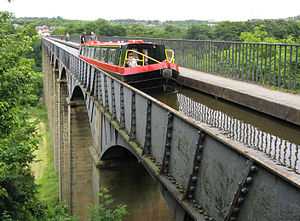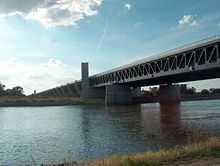Navigable aqueduct

Navigable aqueducts (sometimes called water bridges) are bridge structures that carry navigable waterway canals over other rivers, valleys, railways or roads. They are primarily distinguished by their size, carrying a larger cross-section of water than most water-supply aqueducts. Although Roman aqueducts were sometimes used for transport, aqueducts were not generally used until the 17th century when the problems of summit level canals had been solved and modern canal systems started to appear. The 662-metre long steel Briare aqueduct carrying the Canal latéral à la Loire over the River Loire was built in 1896, and remained the longest navigable aqueduct in the world until the 21st century, when the Magdeburg Water Bridge in Germany took the title.
Early aqueducts such as the three on the Canal du Midi had stone or brick arches, the longest span being 18.3 metres on the Cesse Aqueduct, built in 1690. However the weight of the construction to support the trough with the clay or other lining to make it waterproof made these structures clumsy, and it was not until 1796 that the first large cast iron aqueduct was built by Thomas Telford at Longdon-on-Tern on the Shrewsbury Canal. It has a total length of 57 metres across three intermediate piers. Within ten years Telford had completed the far more ambitious Pontcysyllte Aqueduct on the Llangollen Canal over the River Dee valley—total length 307 metres. Other cast iron aqueducts followed such as the single-span Stanley Ferry Aqueduct on the Calder and Hebble Navigation in 1839, with its innovative 50-metre through arch design.
Notable navigable aqueducts

- Benjamin Outram's 44 ft-long single-span Holmes Aqueduct on the Derby Canal in Derby was the world's first navigable cast iron aqueduct, narrowly pre-dating Thomas Telford's 186 ft-long Longdon-on-Tern aqueduct on the Shrewsbury Canal, sometimes described as the world's first large-scale navigable cast iron aqueduct. The oldest currently navigable cast iron aqueduct is Outram's Stakes Aqueduct on the Huddersfield Narrow Canal at Stalybridge, built c1801 to replace an original, stone-built, four arch structure, which was swept away in the floods of August 1799.
- Pontcysyllte Aqueduct (307m) carries the Llangollen Canal over the River Dee valley in north Wales, and was designed by Thomas Telford and opened in 1805. The same canal, which includes a tunnelled section, crosses a second valley on the Chirk Aqueduct (1796–1801). This navigable canal also supplies water to the former borough of Crewe and Nantwich.
- The Union Canal in Scotland has many aqueducts, including the Slateford Aqueduct that takes the canal over the Water of Leith, the Almond Aqueduct over the River Almond at Ratho and the very impressive Avon Aqueduct over the River Avon. This is the second longest aqueduct in the United Kingdom.
- The Agen aqueduct (1849), in France, is 539 metres long and carries the canal de Garonne across the Garonne river.

- The Briare aqueduct (1896) near Châtillon-sur-Loire, France, carries the Canal latéral à la Loire in a steel channel over the Loire river. At 662 metres, it was the longest canal aqueduct in the world for a century.
- In recent years the building of the Lichfield Canal Aqueduct prompted the UK government to pass legislation preventing a road being built in the path of a canal being renovated without providing a tunnel or aqueduct for it to pass.

- Barton Swing Aqueduct is a swing bridge that carries the Bridgewater Canal across the lower Manchester Ship Canal. A 234 ft (71 m) section of the aqueduct rotates through 90 degrees to allow vessels to pass along the Ship Canal.
- An aqueduct near Roelofarendsveen, Netherlands (1961) (52°12′55.96″N 4°37′35.46″E / 52.2155444°N 4.6265167°E) carries the Ringvaart canal over the A4 highway and the HSL-Zuid, which are situated on land below the level of the canal (and below sea level).
- Gouwe aqueduct, near Gouda in the Netherlands, carries the Gouwe river over the A12 highway, which is on land below the level of the river.
- The Krabbersgat naviduct, Houtribdijk near Enkhuizen, The Netherlands, is the only aqueduct in the world that also operates as a lock.
- The Magdeburg Water Bridge in Germany (2003) connects the important Mittellandkanal over the river Elbe to the Elbe-Havel canal. Nearly 1 km long, it is the longest aqueduct in the world.